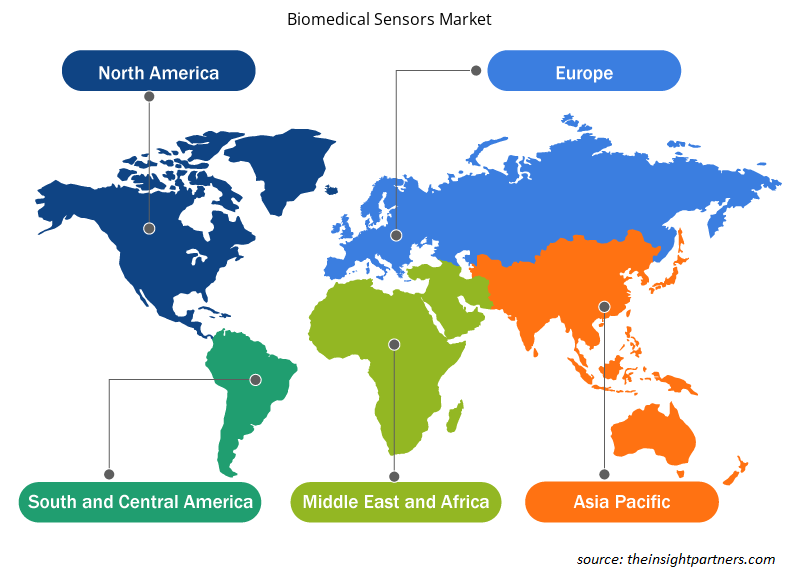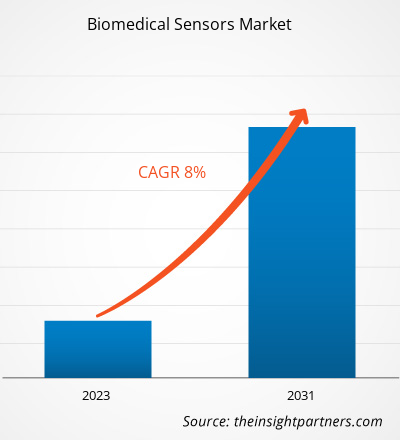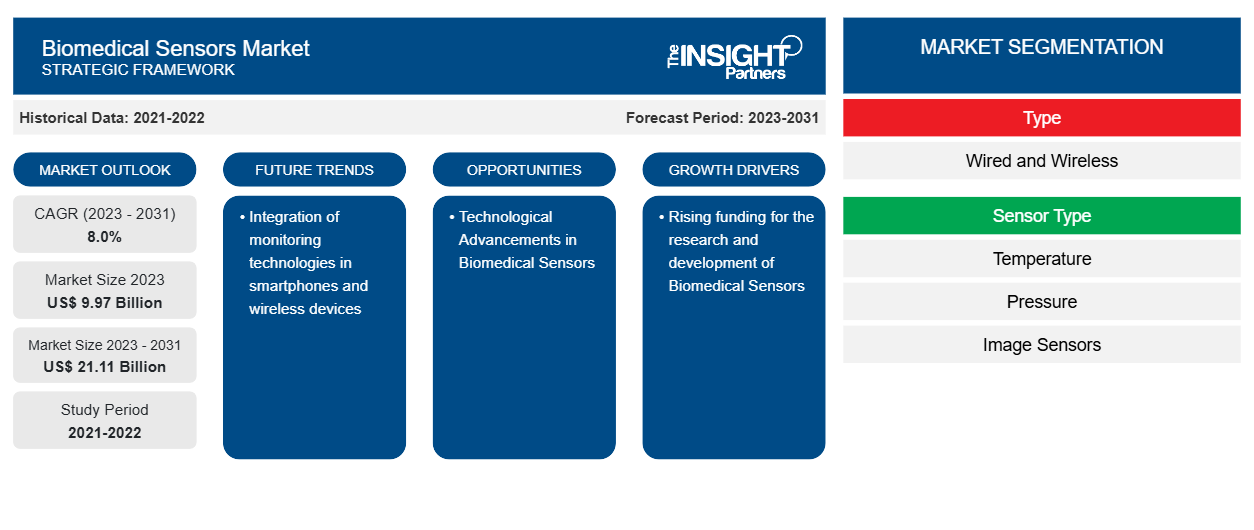生物医学传感器市场规模预计将从 2023 年的 99.7 亿美元增长到 2031 年的 211.1 亿美元;预计 2023-2031 年期间的复合年增长率为 8.0%。智能手机和无线设备中监测技术的集成是生物医学传感器市场的一个关键趋势。
生物医学传感器市场分析
许多私人和政府组织正在筹集资金支持生物医学研究。资金旨在促进生物医学和工程领域院系之间的合作研究,重点是开发生物医学设备、传感器和系统。2023 年 4 月,由国家健康研究所 (NiHR i4i Connect) 资助的 SmartCare:HbA1c 自我监测技术研究项目启动,资助金额为 186.7 美元,主要目标是通过实验验证一种专注于各种血液生物标志物的糖尿病诊断工具。科学技术学院生物医学工程研究中心的 Iasonas Triantis 博士被任命为该研究的首席研究员 (PI)。同样,2024 年 2 月,诺和诺德基金会慷慨地为哥本哈根生物医学量子传感中心的建立提供了 2137 万美元的资助。随着这项计划的实施,生物医学和健康科学领域将随着量子传感技术的出现而发生重大变革。这项尖端技术有望以前所未有的精度彻底改变疾病的诊断和预防。通过这项国际研究合作,科学家们旨在开发可用于疾病早期检测的新型量子传感原理和技术。
生物医学传感器市场概况
生物医学传感器市场的增长归因于多种因素,例如基于物联网的医疗设备的普及、家庭医疗保健需求的不断增长、老年人口的激增、医疗器械行业的技术进步以及全球医疗支出的不断增加。生物医学传感器市场分为北美、欧洲、亚太地区、中东和非洲以及南美和中美。北美占据最大的市场份额,亚太地区预计将在 2023-2031 年期间录得最快的复合年增长率。据估计,美国占生物医学传感器市场的最大份额。美国市场的增长归因于领先的生物医学传感器供应商为建立其主要制造基地所做的努力、人口中急性和慢性疾病发病率的上升以及该国医疗保健领域的技术进步。
定制此报告以满足您的需求
您可以免费定制任何报告,包括本报告的部分内容、国家级分析、Excel 数据包,以及为初创企业和大学提供优惠和折扣
-
获取此报告的关键市场趋势。这个免费样品将包括数据分析,从市场趋势到估计和预测。
生物医学传感器市场驱动因素和机遇
生活方式疾病发病率上升有利于市场
压力、肥胖、久坐不动的生活方式、营养不良以及吸烟和饮酒等各种因素导致生活方式疾病的患病率不断上升,包括心血管疾病 (CVD)。根据美国心脏协会的《心脏病和中风统计——2023》报告,冠心病是 2021 年最常见的心脏病,当年夺走了 375,476 人的生命。据估计,20 岁及以上的成年人中,近 5% 患有冠状动脉疾病(CAD)。因此,随着生活方式疾病发病率的上升,对可用于定期健康监测的生物医学传感器的需求也随之增加。最近推出的最先进的 CVD 生物传感器和监测生物电子设备(无论是可穿戴的还是可植入的)已经能够持续测量心脏标志物。
生物医学传感器技术进步将推动未来市场发展
生物医学传感器的技术进步结合了微技术和纳米技术,带来了紧凑、坚固、创新且经济高效的传感器,这些传感器可适应每个人的基因构成。这些传感器在记录不可预测的读数时会触发警报,筛查血液中是否存在有毒物质,并将药物直接注入循环系统。增加对此类先进传感器的开发和监管批准的投资可能会在未来几年推动生物医学传感器市场的发展。此外,生物医学传感器在纳米技术领域的新兴应用和持续创新正在推动基于传感器的先进非侵入式医疗程序的发展。2020 年 2 月,密苏里科技大学的研究人员设计了一种氧气感应贴片,印在一次性柔性绷带上,可连接到智能手机。这种智能绷带可以进行远程监控,以便及早发现压疮等疾病,从而促进立即治疗或干预。
生物医学传感器市场报告细分分析
有助于得出生物医学传感器市场分析的关键部分是类型、传感器类型、产品和应用。
- 根据类型,生物医学传感器市场分为有线和无线。2023 年,无线部分占据了更大的市场份额。
- 根据传感器类型,市场细分为温度、压力、图像传感器、生化、惯性传感器、运动传感器、心电图和其他传感器类型。温度部分在 2023 年占据了最大的市场份额。
- 就产品而言,市场分为侵入式传感器和非侵入式传感器。非侵入式传感器部分在 2023 年占据了更大的市场份额。
- 根据应用,市场分为医疗诊断、临床治疗、成像和个人医疗保健。医疗诊断领域在 2023 年占据了最大的市场份额。
生物医学传感器市场份额按地区分析
生物医学传感器市场报告的地理范围主要分为五个区域:北美、亚太地区、欧洲、中东和非洲以及南美和中美。北美在全球生物医学传感器市场占据主导地位。根据世界卫生组织 (WHO) 的数据,每年有近 3000 万人患中风。美国心脏协会指出,到 2035 年,美国预计将有超过 1.3 亿人患有某种心血管疾病 (CVD)。因此,心血管疾病患病率的上升归因于北美在全球市场的主导地位。
生物医学传感器市场区域洞察
Insight Partners 的分析师已详尽解释了预测期内影响生物医学传感器市场的区域趋势和因素。本节还讨论了北美、欧洲、亚太地区、中东和非洲以及南美和中美洲的生物医学传感器市场细分和地理位置。

- 获取生物医学传感器市场的区域特定数据
生物医学传感器市场报告范围
| 报告属性 | 细节 |
|---|---|
| 2023 年的市场规模 | 99.7 亿美元 |
| 2031 年市场规模 | 211.1亿美元 |
| 全球复合年增长率(2023 - 2031) | 8.0% |
| 史料 | 2021-2022 |
| 预测期 | 2023-2031 |
| 涵盖的领域 |
按类型
|
| 覆盖地区和国家 |
北美
|
| 市场领导者和主要公司简介 |
|
市场参与者密度:了解其对商业动态的影响
生物医学传感器市场正在快速增长,这得益于终端用户需求的不断增长,而这些需求又源于消费者偏好的不断变化、技术进步以及对产品优势的认识不断提高等因素。随着需求的增加,企业正在扩大其产品范围,进行创新以满足消费者的需求,并利用新兴趋势,从而进一步推动市场增长。
市场参与者密度是指在特定市场或行业内运营的企业或公司的分布情况。它表明在给定市场空间中,相对于其规模或总市场价值,有多少竞争对手(市场参与者)存在。
在生物医学传感器市场运营的主要公司有:
- 认知功能
- 芒果健康
- 邦奇球
- Ayogo健康公司
- Fitbit 公司
免责声明:上面列出的公司没有按照任何特定顺序排列。

- 了解生物医学传感器市场的主要参与者概况
生物医学传感器市场新闻和最新发展
生物医学传感器市场通过收集一手和二手研究后的定性和定量数据进行评估,其中包括重要的公司出版物、协会数据和数据库。以下列出了生物医学传感器市场的一些关键发展:
- 雅培收购了 Bigfoot Biomedical,该公司在为糖尿病患者开发智能胰岛素管理系统方面拥有专业知识。Bigfoot Biomedical 开发的 Bigfoot Unity 智能胰岛素管理系统采用连接的胰岛素笔帽,其操作基于集成的持续血糖监测 (iCGM) 数据和医疗保健提供者的指示。(来源:雅培,新闻稿,2023 年)
- Onera Health 推出了其首款 Onera 生物医学芯片实验室。该生物医学传感器芯片系统旨在获取和处理多种生物信号,适用于各种可穿戴健康设备以及应用。它为医疗、健康和健身行业的创新提供了许多解决方案和机会。(来源:Onera Technologies BV,新闻稿,2022 年)
生物医学传感器市场报告覆盖范围和交付成果
“生物医学传感器市场规模和预测(2021-2031)”报告对以下领域进行了详细的市场分析:
- 生物医学传感器市场规模及全球、区域和国家层面所有主要细分市场的预测
- 生物医学传感器市场趋势以及市场动态,如驱动因素、限制因素和关键机遇
- 详细的 PEST/波特五力分析和 SWOT 分析
- 生物医学传感器市场分析涵盖主要市场趋势、全球和区域框架、主要参与者、法规和最新市场发展
- 行业格局和竞争分析,涵盖市场集中度、热图分析、知名参与者以及生物医学传感器市场的最新发展
- 详细的公司简介
- 历史分析(2 年)、基准年、预测(7 年)及复合年增长率
- PEST和SWOT分析
- 市场规模、价值/数量 - 全球、区域、国家
- 行业和竞争格局
- Excel 数据集
近期报告
相关报告
客户评价
购买理由
- 明智的决策
- 了解市场动态
- 竞争分析
- 客户洞察
- 市场预测
- 风险规避
- 战略规划
- 投资论证
- 识别新兴市场
- 优化营销策略
- 提升运营效率
- 顺应监管趋势























 获取免费样品 - 生物医学传感器市场
获取免费样品 - 生物医学传感器市场